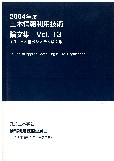
Journal of Applied Computing in Civil Engineering, in 2004
|Return|
You can get the document of full-paper in pdf by clicking at the title part.
| Development of Spread Sheet-Based Supporting System for Land-Use Concept Planning | |
| Hirohito Kojima | Member of JSCE, Dr. Eng., Associate Professor, Department of Civil Engineering, Tokyo University of Science (TUS) |
| Shigeyuki Obayashi | Member of JSCE, Dr. Eng., President of Land Information Technology Laboratory (LITELA) Co., Ltd. |
| Takahiro Otaki | Member of JSCE, Space Engineering Development Co.,Ltd. |
| Toru Suzuki | Member of JSCE, Japan System Development Co., Ltd. |
| <Abstract> For better supporting in making the land-use plans, the Spread sheet-based supporting system for the Land-Use Concept planning (Sp-LUC) are newly designed and constructed. As the kernel system, the land-use capability classification model (Kojima and Obayashi, 1991) integrating the satellite remote sensing data jointly with the geographical information is introduced. The Sp-LUC consists of the following systems; i) Pre-processing system, ii) Analysis system, iii) Post-processing system, and iv) Information providing & management system. The pre-processing system and the post-processing system are operated under the internet-environment, while the analysis system could be executed in the spread-sheet environment. Furthermore, the analysis system is equipped with the following two sub-systems; i) the land use capability classification system, and ii) the mutual regulation supporting system based on the AHP(Analytic Hierarchy Processing) method. The system designs on the Sp-LUC might be a good guide for constructing the cooperating system on the spatial data integration and analysis under the spread sheet- and the internet-environment. | |
| <Keywords> spread sheet environment, network environment, cooperating system, land use conception plan, satellite remote sensing data, spatial data integration and analysis, quantification method, Analytic Hierarchy Process(AHP) | |
| The study of traffic safety at intersections by micro-traffic simulation | |
| Kazuhiko Takashima | Member of JSCE, Ph.D., Japan Constraction Information Center |
| Hirotaka Koike | Fellow of JSCE, Ph.D., Professor, Department of Civil Engineering, Utunomiya University. |
| Akinori Moromoto | Member of JSCE, Ph.D., Associate Professor, Department of Civil Engineering, Utunomiya University. |
| <Abstract> Traffic safety measures are generally designed based on historical traffic accident data. Therefore it is difficult for us to evaluate the exact effect of proposed junction modifications until the works are constructed and new accident data gathered. In particular, safety improvements may be designed in accordance with existing traffic flows, but the characteristics of traffic flow will change once the improvements are made. To address this problem, we examined the use of micro-traffic simulation using software packages NETSIM and Simr to model the effect of junction safety improvements. Actual case studies were modelled, and as a result, new safety evaluation techniques for junctions are proposed. | |
| <Keywords> traffic safety, traffic accident, simulation, intersection, junction | |
| CONSTRUCTION OF CONVENIENT SIMULATION SYSTEM OF SPREADING FIRE IN AN EARTHQUAKE USING DIGITAL RESIDENTIAL MAPS | |
| Osamu Tsujihara | Member of JSCE, Ph.D., Associate Professor, Wakayama National College of Technology |
| Yu-ki Fushimi | Student, Wakayama National College of Technology |
| Takayoshi Kubori | Member of JSCE, Student, Tokushima University |
| Tsutomu Sawada | Member of JSCE, Ph.D., Professor, Tokushima University |
| <Abstract> The objective of this study is to develop the convenient simulation system of the spreading fires at an earthquake. Generally, it requires a tremendous labor to make the data which are used for this kind of simulation. This system needs some attribute data and the coordinate of each residence which can be picked up with a digital residential map in a simple manner besides the data about the wind direction, wind velocity and seismic intensity. A work file is produced with the basic data and the simulation of the spreading fire is formulated as the shortest route problem, which is solved by the Dijkstrafs algorithm. The results of the simulation can be shown on the digital residential map of computer display. | |
| <Keywords> simulation system of spreading fires, earthquake, digital residential map, shortest route problem | |
|Return|